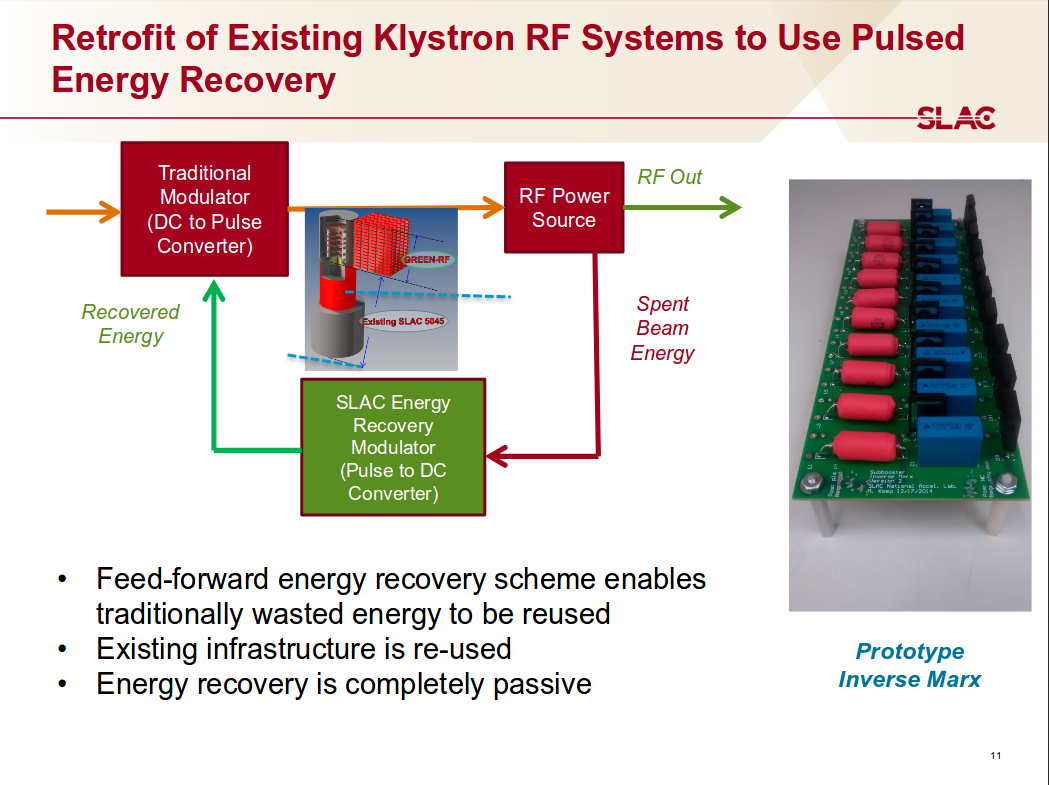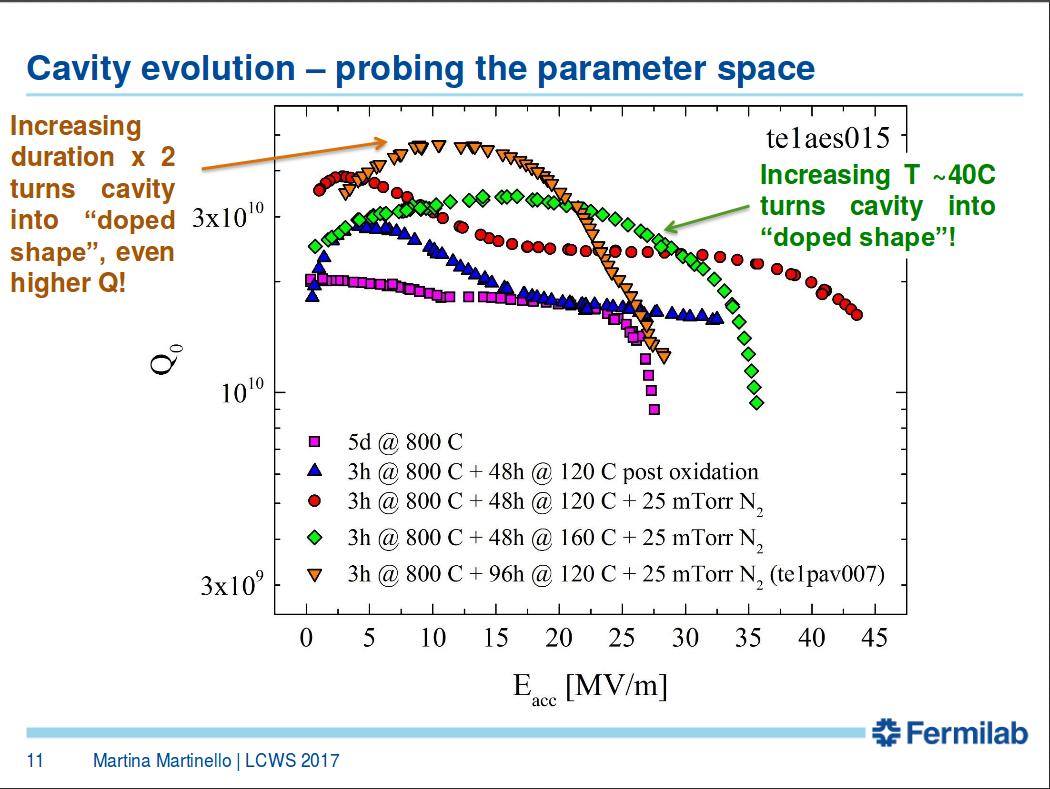 One of the take-home messages from the last LCWS 2017 (International
Workshop on Future Linear Colliders), held in Strasbourg (Oct. 23-27, 2017)
is the amazing progress made towards reducing colliders energy consumption.
One of the take-home messages from the last LCWS 2017 (International
Workshop on Future Linear Colliders), held in Strasbourg (Oct. 23-27, 2017)
is the amazing progress made towards reducing colliders energy consumption.
ILC, CLIC, material science and technology experts reported on expected great saving in the short to medium terms on the main accelerating components. As mentioned in an introduction talk (IN2P3-KEK D. Perret-Gallix), these progresses were fueled mainly by:
- National or international regulations: Enforcement or incentive from new environmental regulations or recommendations (e.g. European 20-20-20 package or the US Site Sustainability Plan) are pushing laboratories and large research infrastructures towards environmental and energy sustainability aware approaches.
- Social acceptance: With LHC (~ 180 MW) running, CERN uses 1.35 TWh/y, roughly the equivalent consumption of 300.000 UK home. Besides ILC (1 TeV), all new future colliders are breaking the socially acceptable glass ceiling informally set at 300 MW for a basic research infrastructure.
- Energy consumption realism:
Furthermore, when energy consumption reaches the level of a nuclear reactor
production like some of the proposed projects, it
becomes unrealistic in term of capital investment, management and social acceptance.
- Capital and running cost saving:
The capital cost is directly related to the length of the tunnel housing the
accelerating structures.
If the accelerating voltage by unit length (or gradient)
is increased, the number of accelerating cells is reduced as well as the
tunnel total length and therefore the overall cost.
As far as the running cost is concerned, due to the high and rising price of electricity, the yearly electricity bill becomes outrageously large yielding up to 14% of the average capital cost per year of running (ILC in Japan). Reducing the power consumption is a must.
Today, energy consumption is becoming a show stopper for some of the future projects, although the concern is not really new. All along the accelerator development history, accelerator physicists and engineers have been tackling this limitation by inventing new paradigms: circular instead of linear machines, colliders instead of fixed target experiments, superconducting instead of normal conducting (magnets and cavities), etc…
More recently, in neutron physics, ESS has been pioneering the 3R concept: responsible, renewable, recycle. As often mentioned in this blog (here) the European Spallation Source laboratory in Lund (Sweden) is currently implementing a zero carbon operation using wind energy and recycling heat wastes to local industries and households.
It is now clear that the future of accelerator physics heavily relies on solving the energy consumption issue. All efforts are now directed to the following targets: improvement of the component efficiency, energy consumption aware operation, energy recovery, recycling and storage as well as the incorporation of renewable energies in the global mix.
On the first item, namely energy saving, remarkable and encouraging progresses have been presented at LCWS 2017, mainly on the following components:
Klystrons (RF)
The driving RF power provided by the klystron tubes takes the lead in the linac electrical power inventory. Increasing klystron power efficiency has a major impact on the global collider energy consumption. A klystron is actually a small electron accelerator where the electron beam is bunched by the input low power RF signal delivering a high power microwave when reaching the output or catcher cavity.

-
High efficiency bunching techniques such as the “Core Oscillations Method” (COM) may lead to an efficiency increase from 45% up to 60% and maybe 70% (CERN/SLAC W. Wuench) and, although not presented at LCWS, the Kladistron embedding more intermediate bunching cavities may increase the efficiency from 50% to 60% (CEA Thales under EUCARD2, e.g see here)
-
Saving energy by recycling the spent electron beam power using depressed collectors. This power recovery could increase the efficiency to 75-80% and reduce the water cooling needs (CERN/SLAC W.Wuench).
-
Going from normal to superconducting for the solenoid surrounding the klystron tube could reduce by 90% the magnet consumption inducing, for example, a reduction of 80 MW on the CLIC power inventory (CERN-KEK, A. Yamamoto)
Superconducting Cavities (SCC)
The RF cavities fed by the klystrons are resonating elements which transfer the microwave power to the beam.

- Nitrogen infusion and doping:
A year ago or so, Fermilab has shown that nitrogen infusion at
high temperature in the last stage of the cavity surface treatment,
increases by a factor 2 the quality factor Q0. As Q0 is inversely
proportional to the remaining surface resistance of the SCC, the
generated heat is proportionally reduced and, therefore, the cryogenic power
needed. In addition higher gradient, namely the accelerating “power” by unit
length (MV/m) is also increased (Fermilab, M. Martinello)
This breakthrough sparkled many R&D efforts. Some with on-going mixed results
calling for bringing special care to the baking process:
- DESY, (M. Wenskat)
- KEK, Infusion/doping (K. Umemory)
- IHEP, Infusion/doping, (J. Zhai)
- JLAB, (P. Dhakal)
- Nb3Sn coating: Compared to Nb, Nb3Sn has a higher critical temperature which means lower heat losses (Q0 is 20 times larger than for Nb at 4.2K) and a higher superheating field which could translates into a higher gradient ( up to 90 MV/m for a “perfect” surface and no grain boundaries issues) (Cornell, R. Porter). In comparison, the ILC is based on a cavity gradient of 31.5 MV/m, showing there is a lot of room for improvement and cost reduction. However the R&D is in a very early stage and many issues must be solved.
- Magnetic shielding will reduce the pinning flux in the SC and therefore, again, the surface resistance (ICR Kyoto Y. Iwashita) see also former studies at CEA by O. Napoly at AWLC)
- Insulating layer: Another approach is to introduce a thin insulating layer between the bulk Nb and a surface NbN layer to block avalanches which prevent reaching higher gradients. Local magnetometry on a sample shows that a doubling the gradient could be achieved on the ILC cavities (CEA C. Antoine). However reaching the same level of improvement on a full-fledge cavity is not given and more studies and investment are needed.

Permanent magnets
Even linear colliders have lots of magnets: quadrupoles to focus the beam all along the linac or bending magnets, (dipoles) in particular in the damping rings (where the beam bunches are shaped before acceleration). In the CLIC project their consumption amount to 124 MW, 21% of the total CLIC expected consumption at 3 TeV. The CLIC design group has launched a dedicated R&D to replace the electromagnets by adjustable permanent magnets (Superconducting magnets would have imposed the addition of a cryogenic plant only for this purpose as the whole CLIC project is non superconducting) (CERN S. Stapnes). Prototypes are being tested.
Local Saving and Recycling for ILC (Green-ILC)
- Reducing the losses in the large power line electrical transformers and using local renewable energy have been studied on the Tohoku site studies (KEK T. Saeki).
- Recycling heat wastes and local energy availability have also been reported. (Tohoku Iwate, M. Yoshioka).
Since the TESLA project, 16 years ago at DESY, for a long time, not much progress has been made on the SCC linac performances or efficiency. The TESLA design was considered as the state of the art, difficult to beat. But since the ILC proposal is now entering the actual implementation stage and based on lessons learned from the construction of the free electron laser XFEL in DESY (a scaled down version of the ILC linac), new R&D have been launched producing today exciting results. They are expected to lead to large saving both in capital and running cost paving the way to reaching even higher energies.
It should be noted that the SCRF R&D would be dramatically boosted would a green-light be given to the ILC project. Beyond the big impact to the project it-self, it would directly benefit the industrial and medical accelerator sector (an currently estimated park of ~30000 equipments in the world). Similarly low consumption klystrons are paramount for satellite communications, mobile radars, energy transmission and defense.